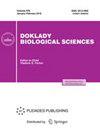不同单子叶植物叶片中氮和磷含量的差异
Q3 Agricultural and Biological Sciences
Doklady Biological Sciences
Pub Date : 2024-08-01
Epub Date: 2024-07-01
DOI:10.1134/S001249662470100X
引用次数: 0
摘要
研究了五个单子叶植物科的叶片中氮(N)和磷(P)的含量:研究了五种单子叶植物的叶片中氮(N)和磷(P)的含量。研究发现,不同单子叶植物科的物种叶片中氮和磷的含量及其比例各不相同。鸢尾科植物的氮含量最低,金莲花科植物的氮含量最高。氮含量最低的是茜草科和蒲葵科,最高的是金莲花科和鸢尾科。鸢尾科的氮磷比最小,而蒲葵科的氮磷比最大。由此可见,单子叶植物中的氮和磷含量及其比例有一定的特殊性。本文章由计算机程序翻译,如有差异,请以英文原文为准。

Plants of Different Monocot Families Differ in Nitrogen and Phosphorus Contents in Leaves.
The folia content of nitrogen (N) and phosphorus (P) were studied in five monocot families: Amaryllidaceae, Cyperaceae, Iridaceae, Orchidacea, and Poaceae. The species of different monocot families were found to have different amount of N and P and their ratio in the leaves. The lowest N content was in Iridaceae and the highest was in Amaryllidaceae. The lowest P content was in Cyperaceae and Poaceae while the highest was in Amaryllidaceae and Iridaceae. A minimum N/P ratio was observed in Iridaceae; a maximum N/P ratio, was in Poaceae. Thus, certain specifics were detected in the content of N and P and their ratio in the monocot families.
求助全文
通过发布文献求助,成功后即可免费获取论文全文。
去求助
来源期刊

Doklady Biological Sciences
Agricultural and Biological Sciences-Agricultural and Biological Sciences (all)
CiteScore
1.10
自引率
0.00%
发文量
66
期刊介绍:
Doklady Biological Sciences is a journal that publishes new research in biological sciences of great significance. Initially the journal was a forum of the Russian Academy of Science and published only best contributions from Russia in the form of short articles. Now the journal welcomes submissions from any country in the English or Russian language. Every manuscript must be recommended by Russian or foreign members of the Russian Academy of Sciences.
 求助内容:
求助内容: 应助结果提醒方式:
应助结果提醒方式:


